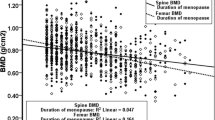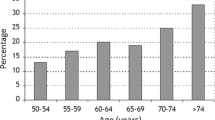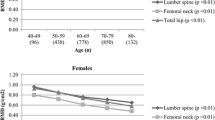Abstract
Osteoporotic studies conducted exclusively in men have been limited by the discrepancies in defining densitometric osteoporosis and, also, because osteoporosis has traditionally been associated only with women. The aims of this study were to describe the prevalence of low bone mineral density (BMD) and osteoporotic fractures as well as the rate of bone loss. The analysis of some risk factors for accelerated bone loss was also evaluated. Men aged 50 years and over, randomly selected from the Oviedo municipal register (n=308), completed a questionnaire regarding risk factors related to osteoporosis; they underwent two lateral radiographs of the dorsal and lumbar spine and a dual X-ray absorptiometry (DXA) study at the lumbar spine and hip. In the 4th year of the follow-up period, participants were invited to undergo repeats of the same tests that had been carried out in the initial study. The prevalence of densitometric osteoporosis in men older than 50 years, standardized by age, was 8.1% with regard to at least one of the four studied bone areas, with a slight increase with age. The prevalence of osteoporotic fracture, standardized by age, was 24.4%, with a marked increase with age. Osteoporotic prevalent fracture was independently associated only with the rate of change in lumbar spine BMD. From all the osteoporotic risk factors analyzed, only low milk consumption and regular smoking were independently associated with loss of bone mass. In summary, prevalent osteoporotic fracture was independently associated with the rate of change in the lumbar spine BMD but not in the other segments studied. Avoiding smoking and ensuring an adequate milk intake might prevent the loss of bone mass in men.


Similar content being viewed by others
References
Osteoporosis prevention, diagnosis, and therapy (2001) JAMA 285:785–795
WHO Study Group (1994) Assessment of fracture risk and its application to screening for postmenopausal osteoporosis. WHO Technical Report Series 843. Geneva, Switzerland
Melton LJ 3rd (2001) The prevalence of osteoporosis: gender and racial comparison. Calcif Tissue Int 69:179–181
Binkley NC, Schmeer P, Wasnich RD, Lenchik L, International Society for Clinical Densitometry Position Development Panel and Scientific Advisory Committee (2002) What are the criteria by which a densitometric diagnosis of osteoporosis can be made in males and non-Caucasians? J Clin Densitom 5 [Suppl]: S19–S27
Kanis JA, Gluer CC (2000) An update on the diagnosis and assessment of osteoporosis with densitometry. Committee of Scientific Advisors, International Osteoporosis Foundation. Osteoporos Int 11:192–202
De Laet CE, van Hout BA, Burger H, Hofman A, Pols HA (1997) Bone density and risk of hip fracture in men and women: cross sectional analysis. BMJ 315:221–225
Kelly PJ, Pocock NA, Sambrook PN, Eisman JA (1990) Dietary calcium, sex hormones, and bone mineral density in men. BMJ 300:1361–1364
Snow-Harter C, Whalen R, Myburgh K, Arnaud S, Marcus R (1992) Bone mineral density, muscle strength, and recreational exercise in men. J Bone Miner Res 7:1291–1296
Glynn N, Meilahn EN, Charron M, Anderson SJ, Kuller LH, Cauley JA (1995) Determinants of bone mineral density in older men. J Bone Miner Res 10:1769–1777
Bendavid EJ; Shan J, Barret-Connor E (1996) Factors associated with bone mineral density in middle-aged men. J Bone Miner Res 11:1185–1190
Huuskonen J, Väisänen SB, Kröger H, et al (2000) Determinants of bone mineral density in middle aged men: a population-bases study. Osteoporos Int 11:702–708
O’Neill TW, Felsenberg D, Varlow J, et al (1997) The prevalence of vertebral deformity in European men and women: The European Vertebral Osteoporosis Study. J Bone Miner Res 11:1010–1018
Gómez Alonso C, Díaz López JB, Virgós MJ, Serrano M, González Carcedo MA, Cannata JB (1990) Assessing in the long term basis precision error of dual-energy X-ray absorptiometry. In: Christiansen C, Oveergard K (eds) Osteoporosis. Osteopress, Copenhagen, pp 883–884
Hamdy RC, Petak SM, Lenchik L (2002) Which central dual X-ray absorptiometry skeletal sites and regions of interest should be used to determine the diagnosis of osteoporosis? J Clin Densitom 5 [Suppl]: S11–S18
Looker AC, Wahner HW, Dunn WL, et al (1998) Updated data on proximal femur bone mineral levels of US adults. Osteoporos Int 8:468–489
Gómez Alonso C (1996) Valores de la densidad mineral ósea (BMD) en columna lumbar y cadera de la población sana española. En: Díaz Curiel M, Díez Pérez A, Gómez Alonso C, FHOEMO-SEIOMM-RPR (eds) Nuevas fronteras en el estudio de la densidad osea en la población española. Rhone Poulenc Rorer, Madrid, pp 73–94
Genant HK, Wu CY, Van Kujik C, Nevitt MC (1993) Vertebral fracture assessment using a semiquantitative technique. J Bone Miner Res 8:1137–1148
O’Neill TW, Marsden D, Matthis C, et al (1995) Survey response rates: national and regional differences in a European multicentre study of vertebral osteoporosis. J Epidemiol Community Health 49:87–93
Díaz Curiel M, Turbí Disla C, Rapado A, García JJ, en representación del grupo de trabajo en osteoporosis (GTO) y del “proyecto multicéntrico de investigación en osteoporosis” (1997) Prevalencia de osteopenia y osteoporosis densitométrica en la población masculina española. Rev Esp Enferm Metab Oseas 6:129–132
Tenenhouse A, Joseph L, Kreiger N, et al (2000) Estimation of the prevalence of low bone density in Canadian women and men using a population-specific DXA reference standard: the Canadian Multicentre Osteoporosis Study (CaMos). Osteoporos Int 11:897–904
Melton LJ, 3rd, Atkinson EJ, O’Connor MK, O’Fallon WM, Riggs BL (1998) Bone density and fracture risk in men. J Bone Miner Res 13:1915–1923
Duan Y, Turmer CHH, Kim BT, Seeman E (2001) Sexual dimorphism in vertebral fragility is more the result of gender differences in age-related bone gain than bone loss. J Bone Miner Res 16:2267–2275
The European Prospective Osteoporosis Study Group (2002) The relationship between bone density and incident vertebral fracture in men and women. J Bone Miner Res 17:2214 –2221
Naves M, Díaz López JB, Gómez C, Rodríguez Rebollar A, Rodríguez García M, Cannata Andía JB (2003) The effect of vertebral fracture as a risk factor for osteoporotic fracture and mortality in a Spanish population. Osteoporos Int 14:520–524
Legrand E, Chappard D, Pascaretti C, et al (2000) Bone mineral density and vertebral fractures in men. Osteoporos Int 10:265–270
Hannan MT, Felson DT, Dawson-Hughes B, et al (2000) Risk factors for longitudinal bone loss in elderly men and women: The Framingham Osteoporosis Study. J Bone Miner Res 15:710–720
Burger H, de Laet CEDH, van Daele PLA, et al (1998) Risk factors for increased bone loss in an elderly population. The Rotterdam Study. Am J Epidemiol 147:871–879
Vogel JM, Davis JW, Nomura A, Wasnich RD, Ross PD (1997) The effects of smoking on bone mass and the rates of bone loss among elderly Japanese–American men. J Bone Miner Res 12:1495–1501
Tanaka T, Latorre MRDO, Jaime PC, Florindo AA, Pippa MGB, Zerbini CAF (2001) Risk factors for proximal femur osteoporosis in men aged 50 years or older. Osteoporos Int 12:942–949
Acknowledgements
This study was partially supported by the European Vertebral Osteoporosis Study (EVOS), European Community (1.991–1.993); the European Prospective Osteoporosis Study (EPOS), European Community BIOMED 93–95. BMHI—CT 092–0182. (1.993 −1.997); Fondo de Investigaciones Sanitarias (FIS 94/1901-E) and by Fundación Renal Iñigo Álvarez de Toledo (Spain). Language consultant was Francesca Pieraccini.
Author information
Authors and Affiliations
Corresponding author
Rights and permissions
About this article
Cite this article
Naves, M., Díaz-López, J.B., Gómez, C. et al. Prevalence of osteoporosis in men and determinants of changes in bone mass in a non-selected Spanish population. Osteoporos Int 16, 603–609 (2005). https://doi.org/10.1007/s00198-004-1727-x
Received:
Accepted:
Published:
Issue Date:
DOI: https://doi.org/10.1007/s00198-004-1727-x




